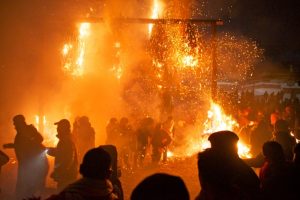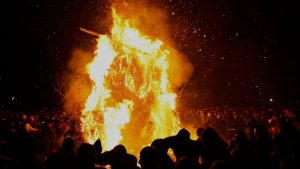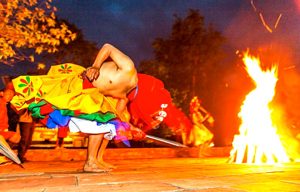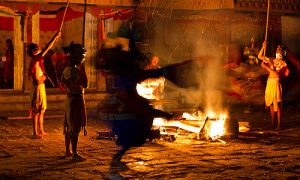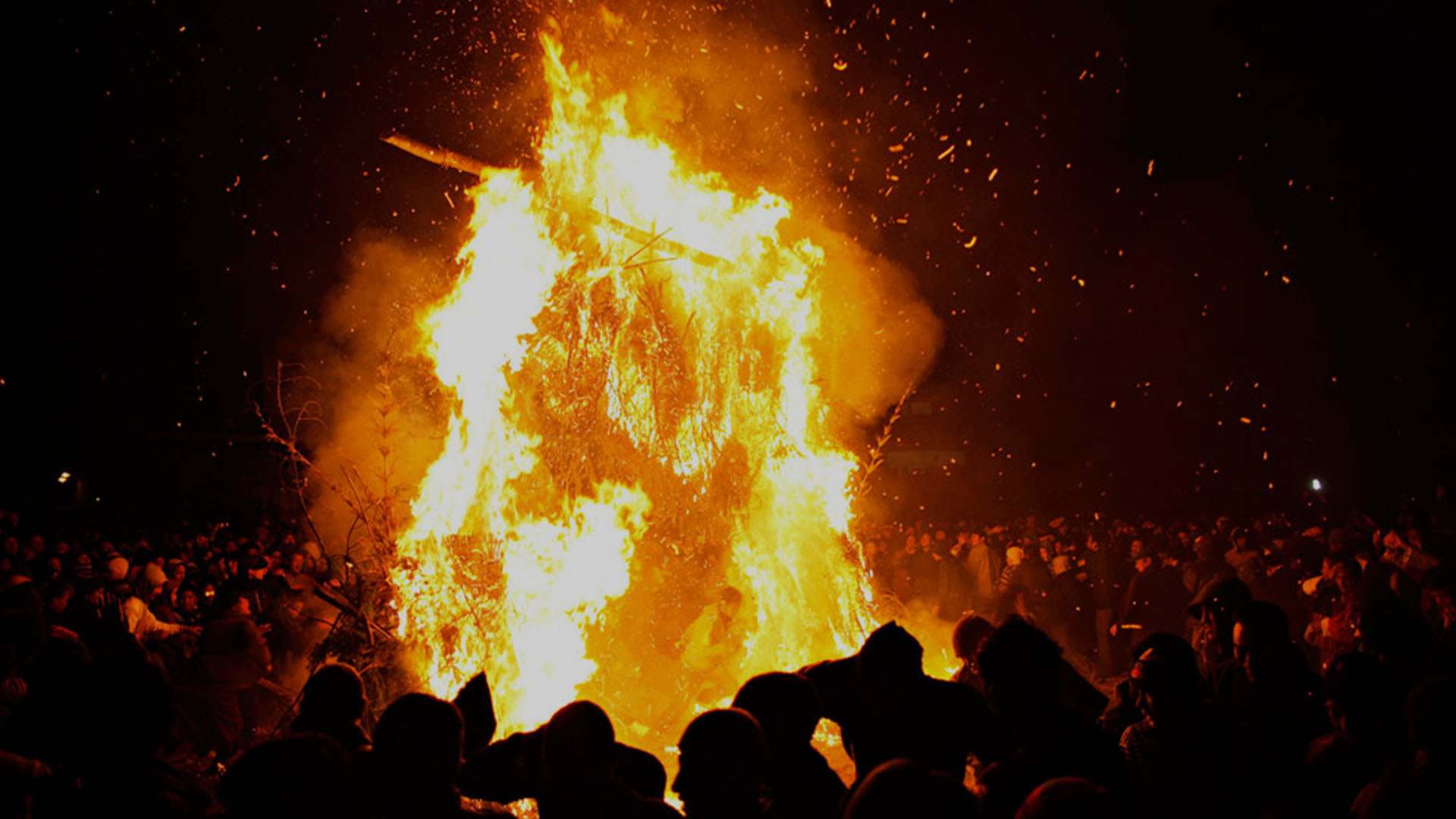
10 Night 11 Day Jambay Lhakhang Festival Tour
10 Night 11 day Bumthang Jambhay Lhakhang Drup Festival from Oct 24-27,2018
A Brief Background on Jambay Lhakhang Drup.
Jampa lhakhang is located in Bumthang.Jampa Lhakhang is one of the oldest temples in the kingdom. It was founded by, Songtsen Gampo, a Tibetan King in the 7th century AD. The king was destined to build 108 temples known as Thadhul- Yangdhul (temples on and across the border) in a day to subdue the demoness that was residing in the Himalayas. The temple is one of the two of the 108 built in Bhutan.
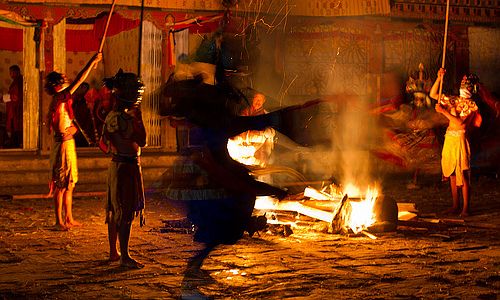
Jambay Lhakhang Festival
The other is the Kichu lhakhang in Paro, believed to have been built on the same day.
Legend has it that Guru Rinpoche visited the site several times and deemed it exceptionally sacred. Chakhar Gyab, the king of the Iron Castle of Bumthang renovated the temple in the 8th century AD.
The first king of Bhutan, Gongsa Ugyen Wangchuck constructed the Dus Kyi Khorlo (Kala Chakra- Wheel of Time) inside the temple, to commemorate his victory over his rivals Phuntsho Dorji of Punakha and Alu Dorji of Thimphu after the battle of Changlimithang in 1885. Later, Ashi Wangmo, the younger sister of the second king of Bhutan, built the Chorten lhakhang.
The main relics include the future Buddha, Jowo Jampa (Maitreya) from whose name the present name of the temple is derived. The Lhakhang also houses more than one hundred statues of the gods of Kalachakra built by the first king, in 1887. Here, one of the most spectacular festivals is hosted called Jamba Lhakhang Drup that lasts for five days beginning from Oct 24-27, 2018. The highlight of the festival is the fire ritual that is held in the evening where crowds gather to witness the ritual together with the naked dance.
Festival Schedule: Oct 24-27,2018.
10 Night 11 Day Jambay Lhakhang Festival Tour
- Day 1:
- Arrive Paro.
Fly into Paro by Drukair flight KB 401 at 14.25. After immigration and customs formalities, you will be received by the representative of Access Bhutan Tours & Treks and driven to your hotel.
After checking into your hotel and lunch visit the following:
- Rinpung Dzong,built in 1645 to defend the valley against Tibetan invaders. The Dzong is now being used as an administration center and school for monks. Then walk down to Rimpung Bridge (Traditonal Bridge), oldest bridge in Bhutan.
- Farm housesin Paro Valley and a visit to a farm house offers a good glimpse into the lifestyle of a farmer.
In the evening visit Paro town where you may visit local handicraft stores.
Dinner and overnight at a hotel in Paro.
- Day 2:
- Paro – Thimphu.
Distance:54 km
Estimated travel time: 1 hour
After breakfast, travel to Thimphu and check into your hotel. Then visit the following as per your interest and time availability:
- Bhutan Post Office Headquarters to get personalized Bhutanese postage stamps with your photo on them. You can bring along your favorite photo to put on the stamps and put these stamps on your postcard to send to your family and friends.
- National Museumwhich is a good place to see the art of traditional weaving being kept alive and preserved through exhibition and has a good collection of old textiles which are rich in colors and designs. You will also see people weaving with intricate designs.
- Simply Bhutan or The Folk Heritage Museum, an outdoor museum that gives an insight into rural life in Bhutan.
- The School of Traditional Painting of Arts and Crafts where students undertake a six-year course on the 13 traditional arts and crafts of Bhutan.
- Centenary Farmers’ market (if tour coincides with Thu-Sun) where farmers would be selling their wide range of farm produces (vegetables from farms and wild ferns or bamboo shoots collected from forest, flour, rice, roasted rice, rice flakes, spices, yams both cultivated and wild ones collected from forests, fruits, etc.) and livestock products (mainly cheese and butter). Free interaction with people from town as well as from villages come to this weekend market. Weekend market is from Thursday-Sunday (4 days).
- The Memrial Chorten which was constructed in 1974 as a memorial for the third King of the country, King Jigme Dorji Wangchuck, who is widely regarded as the father of modern Bhutan.
- Tashichhoe Dzong, a fortress of the glorious religion. It was built in 1641 by Zhabdrung Ngawang Namgyel and was reconstructed into present structure by the late King, His majesty Jigme Dorji Wangchuck in the year 1962-1969. It houses the secretariat building, the throne room and the office of the king, and the central monk body.
- Takin Preserve, which houses the national animal the Takin that is only found in Bhutan. This is an extremely rare member of the goat family. Found in herds in the very high altitudes (13,125ft and over). They live on a diet of grass and bamboo. It can weigh as much as 550 pounds.
- Changankha Lhakhang (temple): This temple situated atop a small hound overlooking the Thimphu valley was built in the 13th century by the illustrious Lam Phajo Dugom Zhigpo. The temple is considered the spiritual home of children born in the Chang valley.
- Kuenselphodrang where largest Buddha statue in the country is perched on the hillock overlooking the Thimphu valley and also if interested/if time permits, take a leisure walk throughKuenselphodrang Nature park and enjoy the nice view of the entire Thimphu valley below
- Craft Bazaar where craftsmen and artisans from across the country display and sell their handicrafts.
- Government-run Handicrafts Emporium and local crafts shops, to browse through examples of Bhutan’s fine traditional arts. Here you can buy hand-woven textiles, thangkha paintings, masks, ceramics, slate and wood carvings, jewelry, and other interesting items made from local materials
In the evening stroll around Thimphu town and you may visit local handicraft stores. Dinner and overnight at a hotel in Thimphu.
- Day 3:
- Thimphu-Punakha/Wangdue.
Distance: 71 km
Estimated travel time: 2 1/2 hrs
After breakfast, drive to Punakha via the Dochula pass. An hour's drive from Thimphu will take you to this pass (3140 m) where one can have a superb view of the Eastern Himalayas on a clear day with a powerful binocular telescope. Visit the beautiful 108 chortens built on the hill by Her Majesty Ashi Dorji Wangmo for the security and wellbeing of His Majesty the King of Bhutan. Also visit Druk Wangyel Temple which was built to honor His Majesty, the fourth king Jigme Singye Wangchuck. The past and future appear to merge in the details of the temple that tells the story of a supreme warrior figure whose vision pierces the distance future.
Drive onto Punakha, the old capital of Bhutan and presently the winter residence of the central monk body. Visit the Punakha Dzong, located on the island of the Pho-Chu (male) river and the Mochu (female) river. Visit the Dho Jha Gha Lam Temple.
In the evening, walk through the Metshina Village and take a 20-minute walk through the rice fields to the Devine Madman’s Monastery-Chhimi Lhakhang, famously known for its fertility shrine, where couples unable to concieve come here for blessing.
Overnight at hotel in Wangdue/Punakha.
- Day 4:
- Punakha/Wangdue-Trongsa.
Distance: 129 km
Estimated travel time: 5 hrs
After breakfast, drive to Trongsa, the ancestral home of the royal family.The drive will take you through dense forests of oak trees and rhododendrons and through the tropical vegetation through the village of Nobding and Pele la pass (11,000ft). Throughout your trip you will come across the beautiful sceneries of rural Bhutan, with scattered settlements far from the road which makes for good photographing.You will also pass through open meadows, and valley of yak herders and several other villages via Chendebji Chorten ( Stupa) where you will stop for a tea break at a convenient spot and drive for another 2 hours to Trongsa. Check into the hotel in Trongsa. After the refreshment,visit the Museumwhich is housed in the Ta Dzong (watch tower).A museum in which aspects of Bhutanese culture and history are explained by beautifully objects. Documentary will be shown too which explains a great deal about Bhutanese history and history of monarchy. Also visit Trongsa Dzong, which is the most impressive dzong in Bhutan. Built in 1644 by the Shabdrung, the dzong is an architectural masterpiece.
Dinner and overnight at hotel in Trongsa.
- Day 5:
- Trongsa-Bumthang.
Distance: 68km
Estimated travel time: 2 hrs.
After breakfast, drive to Bumthang, this is one of the most spectacular valleys in Bhutan and also the heartland of Buddhism. Here the great teachers meditated and left in their wake many sacred grounds. The Guru and his lineage of Tertons, treasure finders, have led to the sprouting of many temples in the valley.On the way, visit the “Yathra” weaving centre at Zugney and spent our afternoon interacting with the local weavers. Yathra is the name for the colorful, hand-woven woolen cloth (often with geometric designs) that is produced in this region and wool used for this type of textile is sheep wool as the sheep is reared in this Bumthang district. Yatra is made into jackets or bags, etc. Then drive onto Bumthang and Check into hotel.
Afternoon, Bumthang sightseeing includes visit to the following:
- Jampa Lhakhang, built in the 7th century by the King Songtsen Goempo of Tibet. In his effort to propagate Buddhism he had a plan to build a total of 108 temples in Tibet and neighboring kingdoms.
- Kujey Lhakhang (Kujey means, "Body imprint"). The temple to the right is the oldest and was built by Minjur Tempa in 1652. It was built around the cave in which Guru Rimpoche meditated and left his body imprint.
- Jakar Dzong, "castle of the white bird". According to legend, when the lamas assembled in about 1549 to select a site for a monastery, a big white bird rose suddenly in the air and settled on a spur of a hill. This was interpreted as an important omen, and the hill was chosen as the site for a monastery and for Jakar Dzong. The fortress is now used as an administrative center of the valley and summer residence of Trongsa monks.
- Tamshing Lhakhang;This temple is also known as Tamshing Lhendrup Chholing (Temple of the Good Message).
In the evening stroll around the beautiful landscape of the Bumthang Jakar valley. After dinner attend the first day of Jambay Lhakhang festival.
The first day of the festival begins in the evening around 8:30 pm. The details of the first day of the festival are as follows:
Black Hat Dance (Shana) and of the Gings (emanations of Guru Rinpoche): Costume: Dancers, wearing long brocade robes and ornate black hats, perform this dance. The dancers’ who represent the Ging wear shorter robes with masks. This dance is performed to purify the ground and to chase away evil influences.
Dance of Offering (Tshogcham): A dancer offers the body of evil spirits to the deities. After the offering is made the audience goes outside the temple where an arch of pine bushes has been erected.
Fire Dance (Mecham): The arch of pine is set on fire. The fire is said to purify the earth of evil spirits. People who pass through the arch have their sins cleansed. A dancer chases away the evil spirits.
Overnight at hotel in Bumthang.
- Day 6:
- Bumthang Jambay Lhakhang Festival.
After breakfast,you will attend the full second day of the Jambay Lhakhang Drup (festival) which will start around 10:30 am. You will be watching many ritual dances, which are performed in the court yard of Jampa Lhakhang. There are a number of different dances, subdivided into three categories: those that are intended to give moral instruction; those that are designed to drive away evil spirits and those that celebrate the Buddhist faith in its many guises. This is the occasion where the local people, dressed in their finest clothes, come to attend the festival with packed lunches. This occasion also gives opportunity to the local businesses- there will be a number of stalls selling craftwork, jewellery, religious artifacts and thangkas. Overnight hotel in Jakar.
Details of the 2nd Day Jambay Lhakhang Drub (festival)are as follows:
It follows a ceremony where a small girl representing the daughter of Sindhu Raja blesses the villagers. Dance of Singje Yab Yum (Lord of death and his consort): The Lord of Death and his consort perform this dance to protect the four realms over which he has power.
Dance of Nyulema and Peling Ging Sum (Three kinds of Ging): The Nyulema is an evil spirit represented by a boy in a skeleton mask. The Ging with the sticks catch the Nyulema. The Durdag or the Lords of the Cremation Ground (represented with dancers wearing white skeletal masks) bring forward a box, which represents evil spirits. The Ging with swords liberate the mind of the evil spirit by killing its body of flesh. The Ging with drums dance to celebrate the victory of religion over the evil spirit.
Dance of the Jachung Bochung (Two mythical birds): Dancers wearing masks representing the auspicious birds perform the dance. The play of the Atsara Gapo Pawo Solgyo (Atsara who acts like a Pawo). Though most of the stories and plays were originally with Buddhist sub text they now serve as comedy relief for the crowd. This story is about an Atsara (clown with a red mask) who is mad. The Atsara injures his son, as he did not recognize him. He tries to save his son’s life by impersonating a pawo or medium and tries to perform a religious curative ceremony. Being unsuccessful he has to finally call a doctor and a monk to cure his son.
Overnight at hotel in Bumthang.
- Day 7:
- Bumthang Jambay Lhakhang Festival.
After breakfast, attend the full day of the 3rd day of Jambay Lhakhang Drub. The program begins at around 10:30am. Below are the details of the day’s program.
Dance of the four stags (Shacham): The King of the Wind was causing much unhappiness and suffering in the world. Ugyen Rinpoche subdued him and then as a sign of victory rode on the stag, which was the mount of the king of the Wind. Later a disciple of Guru Rinpoche, Namkhay Nyinpo found an effigy of the face of the stag which appeared to be a blessing. Thus the dance came into existence.
Dance of Ging Tsoling: The dance is supposed to take place in the paradise of Guru Rinpoche and is performed by incarnations of the Guru. The dance is said to give blessings to those who witness it as well as remove obstacles to the doctrine of the Buddha. People whistle during the dance to chase away evil spirits and the Ging hit people on the head to chase away impurity from the body.
Dramitse Ngacham (Dance of the drums from Dramitse): The creator of this dance was Kuenga Gyeltshen, a learned lama from the 16th Century who lived in Dramitse. He is reputed to have seen the dance in Guru Rinpoche’s paradise performed by attendants of the guru. The dance proclaims the superiority of religion over evil spirits.
Pacham - Dance of the heros: Pema Lingpa (the Treasure-Revealer who discovered many Buddhist treasures) saw this dance in Guru Rinpoche’s paradise. On his return to earth he recreated this dance. The most important attendants of the Guru perform the dance. They lead the beings who die into the presence of the Guru.
Phole Mole: The nobleman and the lady. This ‘play’ is about two princes who leave their princesses and go to war. An old couple is to take care of the princesses. As soon as the princes leave the clowns try to frolic with the princesses and also corrupt the old women. When the princes return they are shocked by the behaviour of the princesses and the old women, and have their noses cut off as a punishment. Finally, a doctor is called and everyone’s nose is restored and the princesses and princes marry.
Overnight at hotel in Bumthang.
- Day 8:
- Bumthang – Punakha via Phojikha.
Distance: 197 km
Estimated travel time: 7 hrs
After early breakfast, drive to Phobjikha valley. You may visit Gangtey Gompa (monastery) which now houses one of the only Nyingmapa monasteries in Bhutan. The valley is also the winter home to the rare black-necked cranes (Grus Nicorocolis), which migrate, from remote parts of Tibet, China and Siberia during winter to this valley. Lunch at Phobjikha and after lunch drive to Punakha. Dinner and overnight at hotel in Punakha.
- Day 9:
- Punakha-Paro
Distance: 125 km
Estimated travel time: 3 1/2 hrs
After breakfast, drive through upper Punakha valley passing through farmhouses and take a leisure walk through farmhouses and then through nature to the beautiful Khamsum Yuelley Namgyal Chorten temple built by the Queen Mother of Bhutan for peace and stability in this ever-changing world. This temple is situated on the hilltop overlooking the valley below. The leisurely walk up to the temple would take about 1 hour. Visit the temple and also enjoy the breathtaking view from there.
After lunch,drive back to Paro. After a refreshment drive up the valley to visit the historic Drukgyel Dzong which was built in the 16th century to mark the Bhutanese victory over the Tibetan invaders.
Dinner and overnight at hotel in Paro.
- Day 10:
- A Day Hike to Taktsang Goempa (Tiger's Nest Monastery) in Paro.
After breakfast, travel to Paro which will take about 1 hour and on arrival at Paro hike to Taktsang Goempa (Tiger's Nest Monastery). The hike upto the viewpoint will take about 1 1/2 hours and from there you will enjoy a spectacular view of the monastery clinging to the side of the cliff. You will stop here for refreshments and then hike further up to the monastery which should take another 1 1/2 hours. It was first built in 1692, around the Taktsang Senge Samdup, a cave where Guru Padmasambhava is said to have meditated for three months in the 8th century. It is believed that Guru Rinpoche (Guru Padmasambhava) flew to this location from Khenpajong, Tibet on the back of a tigress and subdued a demon. He then performed meditation in one of the caves here and emerged in eight incarnated forms (manifestations) and blessed the place. Subsequently, the place came to be known as the “Tiger’s Nest”. Guru Padmasambhava is known for introducing Buddhism to Bhutan. Today, Paro Taktsang is the best known of the thirteen caves in which he meditated. After visiting the monastery, walk back downhill to the road with lunch at the viewpoint cafeteria.
Then drive back to your hotel after visiting Kichu Lhakhang on the way. Kichu Lhakhang, one of the 108 temples built in the 7th century by the Tibetan King Songsten Gampo. The story goes that a giant demon lay across the whole area of Tibet and the Himalayas and was preventing the spread of Buddhism. To overcome her, King Songtsen Gampo decided to build 108 temples, which would be placed on all the points of her body. Of these 108 temples, 12 were built in accordance with precise plans. Thus, it happened that in about the year AD 638 the temple of Jokhang in Lhasa was built over the very heart of the demon.
In the evening relax and overnight at a hotel in Paro.
- Day 11:
- Depart Paro.
After breakfast, your tour guide from Discover Happiness Tours & Travel will see you off at the Paro International Airport for your onward journey.

